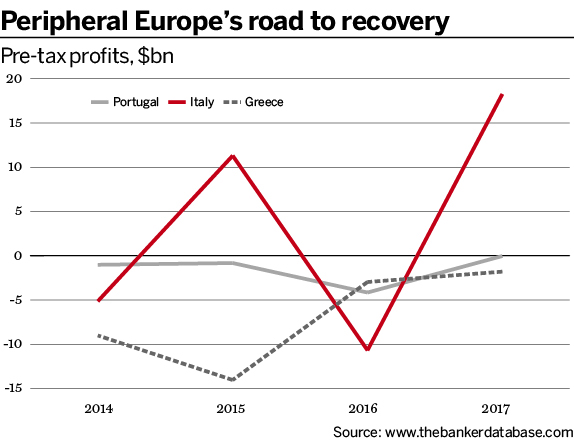Dogged by non-performing loans and the lingering effects of the eurozone crisis, Italy, Greece and Portugal have long-been Europe’s underperformers. But in the 2018 rankings their fortunes improved, resolutely led by their biggest banks.
Italy’s ROE jumped from -9.8% in the 2017 ranking to be on par with Luxembourg and Switzerland, and just shy of western Europe’s average. Nearly all of its lenders turned a profit, a vast improvement on the 2017 ranking, when almost half posted a loss. A key contributor was the nationwide non-performing loans (NPL) selling spree, which has allowed banks to cut their impairment charges and provisions (ICP), the loss recognised on loan books to account for impaired assets, and pushed Italy out of the list of countries with the highest ICP-to-income ratios. Undoubtedly, UniCredit staged the most impressive turnaround. A €13bn rights issue saw it reclaim its status as the country’s biggest bank, and it turned a $10.9bn loss into a $7.8bn profit, thanks in no small part to the sale of a €17.7bn NPL portfolio and subsequent $11bn reduction in ICP.
Portugal posted a loss in the 2018 rankings, but it is a sliver of the $3.65bn loss reported in its 2016 financial results. If it weren’t for one bank – Novo Banco, which posted the 11th biggest loss globally – the sector would have made a sizeable profit. It still managed to bolster its capital cushions by 30.4%, and but for Novo Banco, the national NPL ratio would have shrunk.
The Portuguese banking sector has offloaded NPLs via securitisation and sales, but the market has been underwhelming to date. The fact that ICPs have shrunk by nearly one-third and the ICP-to-income ratio has halved is cause for cautious optimism that NPL stocks will continue to fall. The sector has been dragged up by Caixa Geral de Depósitos (CGD) and its Ä5bn state-supported recapitalisation in 2017. CGD has recovered its crown as Portugal’s biggest bank and posted its first profit since 2010. As at UniCredit, this was aided by cutting its ICP by three-quarters.
Greece’s improvements are more modest, but still notable. The sector-wide NPL ratio dropped eight percentage points, pre-tax losses fell from $3bn to less than $2bn, and Tier 1 capital increased by 10%. ICPs continued to rise, though, suggesting there is still a long road ahead in tackling NPLs. Its biggest lender, Alpha Bank, seems to embody the sector’s state of health. It added $100m in profits but has the world’s fourth highest NPL ratio, despite shaving off a few percentage points in 2017.



